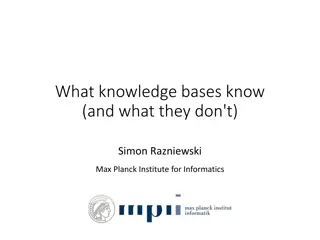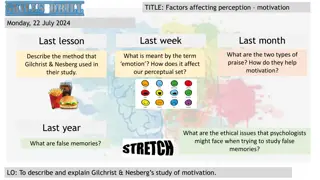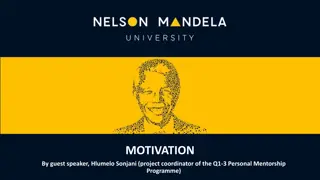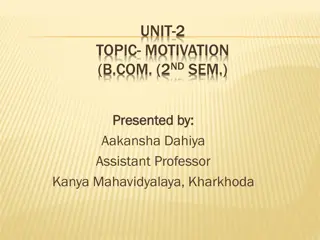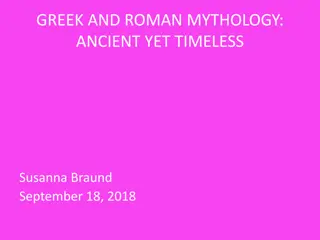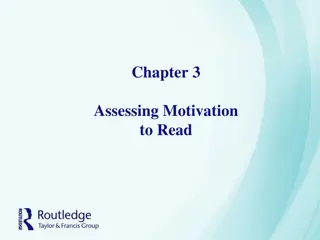FL Archetypes and L2 Motivation Research Commonalities
FL Archetypes and L2 motivation research explore commonalities and contrasts in learner identity, motivation, and learning patterns within second language acquisition. The research delves into the intricate interplay of cognitive, social, and environmental aspects shaping L2 motivation, emphasizing the role of archetypes in sustained learning behavior. It also investigates the significance of learner identity in language acquisition, highlighting the multiple dimensions through which individuals express their social and personal identities in the language learning process.
Download Presentation

Please find below an Image/Link to download the presentation.
The content on the website is provided AS IS for your information and personal use only. It may not be sold, licensed, or shared on other websites without obtaining consent from the author.If you encounter any issues during the download, it is possible that the publisher has removed the file from their server.
You are allowed to download the files provided on this website for personal or commercial use, subject to the condition that they are used lawfully. All files are the property of their respective owners.
The content on the website is provided AS IS for your information and personal use only. It may not be sold, licensed, or shared on other websites without obtaining consent from the author.
E N D
Presentation Transcript
FL Archetypes and L2 motivation research: FL Archetypes and L2 motivation research: Commonalities and contrasts Commonalities and contrasts Conch r Mac Lochlainn, Dr. Mair ad Nic Giolla Mhich l, Stiof n Br ain, Elaine Beirne
Our project Filte ar Lne Irish 101, 102, 103 and 104! Ab-initio language learning to A1 level Strong cultural element Difficulties of teaching a minority language my research focuses on who are our learners (identity) and what do they wish to achieve (motivation)?
L2 learning motivation defined A complex topic, involving cognitive, social, environmental and situated aspects (Williams and Burden, 1997). Simple explanation why, how long and with what intensity? (D rnyei and Ushioda, 2011) Generally considered to have some unique or unusual aspects (D rnyei, 2009) (Gardner, 1985), though much in common with other subjects also (Ushioda, 2009) (Crooks and Schmidt, 1991).
Identity, both social and individual . Learning a language can be thought of as an expression of identity, both from a self-concept perspective (Mercer, 2011) all the way to a form of social investment (Norton, 1995). MOOC learning, for casual purposes, could speak to many identities (Zimmerman, 1998) . Which ones are the critical question!
.bringing us to FL Archetypes An archetype is a pattern of behaviour that others are likely to follow FL Archtypes Deep dive. - 7 main archetypes, split into 3 categories. - To what degree does an archetype represent sustained behaviour? - Methodology is clear but implications less so
Research commonalities - examples In our course, vast majority categorised as Hobbyists, or Vitalisers. Compatible with notions of intrinsic motivation, and learning for its own sake. Such MOOC learning as a casual pursuit? meaning. Evidence of real SLA research concerned with acquisition and continuation, archetypes (to a degree) likewise.
Contrasts Psychological focus on learner motivation within SLA has tended to look for holistic learning patterns, with a shift towards considering context (Ushioda, 2009) (Dornyei, Henry and Muir, 2015). Understanding the process of acquisition has tended to focus on certain temporal points of interest over a lifetime, rather than on underlying traits or behaviour alone. Social attitudes and interaction with others likely critical.
The limits of archetypes Famous person-situation debate (Mischel, 1968) speaks to limits of categorising human behaviour it often depends! Are they posited to have predictive power? Do they hold across differing contexts? What is their ultimate purpose? Credit Flower Travellin man/ Shutterstock
Our research into Irish L2 learner motivation I am on ill-health early retirement because of a head injury which affects my memory. My specialist told me that to learn a language, the less like English the better was the best treatment. I have also always felt a little foolish at not being able to speak my own language. - Learner, Irish 101
Conclusion mixing archetypes and L2 learning Rich lines of research are possible on linking academic motivation (e.g self-concept) of various fields and the concept of learner archetypes. L2 Archetypes research tends to focus more on academically-salient personality traits: e.g. motivated + low proficiency+ unconfident (Chan, Dornyei and Henry, 2015: 6). Focus on learning important, not purely behaviour or traits.
Go raibh maith agaibh! (Guh rav moh ah gwiv) To register for Irish 101 - https://www.futurelearn.com/courses/irish-language Our website - https://www.failteonline.ie/ Follow us on twitter @failteonline
References Chan, Letty, Dornyei, Zoltan and Henry, Alastair. 2015. Learner Archetypes and Signature Dynamics in the Language Classroom: A Retrodictive Qualitative Modelling Approach to Studying L2 Motivation. Crookes, Graham and Schmidt, Richard. 1991. Motivation: Reopening the research agenda. University of Hawai i Working Papers in ESL, Vol. 8, No. 1. PP 217-256. D rnyei, Zolt n. 2009. The L2 Motivational Self System. In Motivation, Language Identity and the L2 self , D rnyei, Zolt n and Ushioda, Ema (Eds.). Bristol: Multilingual Matters. PP 9-43. Garder, Robert. 1985. Social Psychology and Language Learning: the role of attitudes and motivation. London: Edward Arnold. Mercer, Sarah. 2012. Self-concept: situating the self. In Mercer, Sarah, Williams, Marion and Ryan, Stephen (Eds.) Psychology for Language Learning: Insights from theory, research and practice . Springer Press. PP 10-25. Mischel, Walter. 1968. Personality and assessment. New York: Wiley. Norton Peirce, Bonnie. (1995) Social identity, investment, and language learning. TESOL Quarterly Vol. 29, No. 1. PP 9-31. Ushioda, Ema. 2009. A Person-in-Context Relational View of Motivation. In In Z. D rnyei, & E. Ushioda (Eds.), Motivation, language identity and the L2 self . Bristol: Multilingual Matters. PP 215-228. Williams, Marion and Burden, Robert. 1997. Psychology for Language Teachers: A social constructivist approach. Cambridge: Cambridge University Press. Zimmerman, D. H.1998. Discoursal identities and social identities. In C. Antaki and S. Widdicombe (Eds.): Identities in Talk . London: Sage, pp. 87 106.









